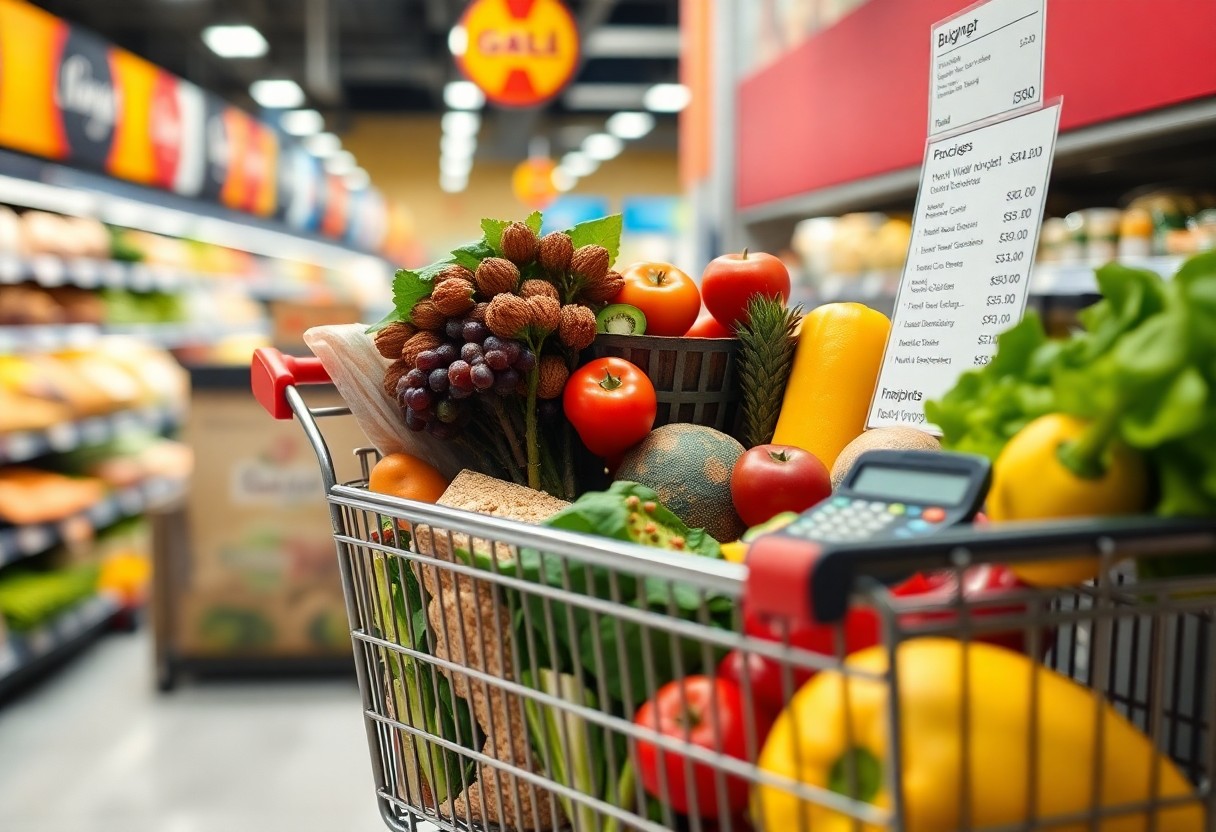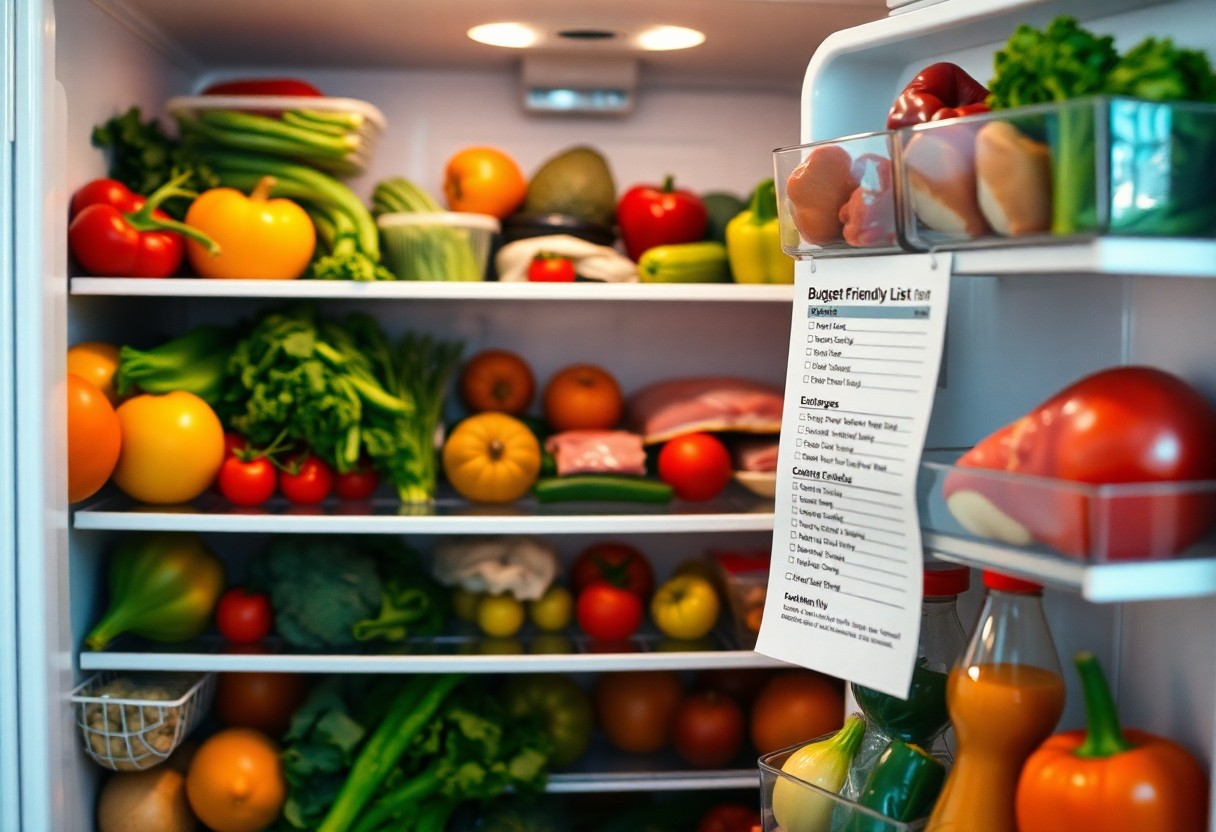It’s possible to shop for groceries in a way that supports your health without breaking the bank. By focusing on seasonal produce, bulk items, and store brands, you can stretch your dollar while still enjoying nutritious and delicious meals. With simple strategies like planning your meals ahead and making a shopping list, you can avoid impulse buys that lead to overspending. This guide provides practical tips to help you achieve a balanced diet, all while keeping your expenses low.

Understanding Your Budget
Grasping your budget is fundamental for effective grocery shopping. Begin by evaluating your income and fixed expenses to determine how much you can allocate for groceries each month. Utilize online resources like Healthy Grocery List on a Budget: 52 Affordable Foods to guide your purchasing decisions while staying within financial limits. Focus on prioritizing imperative items and plan meals around seasonal produce and sales to stretch your dollars further.
Setting a Realistic Grocery Budget
Create a grocery budget that mirrors your lifestyle and dietary needs. Taking into account any specific nutritional requirements you have, like dietary restrictions or preferences, aids in defining how much you should spend weekly or monthly. Allocating approximately 10-15% of your gross income can serve as a guide, but tailor this to strengthen your health without compromising your financial goals.
Tracking Grocery Expenses
Monitoring your grocery expenses is vital for staying on track. By documenting each purchase, you gain insights into spending habits and can identify areas where you might overspend. Utilizing apps and spreadsheets aids in visualizing your grocery expenditures, making it easier to adjust spending habits where necessary.
Employ tools like expense tracking apps or simple spreadsheets to log your grocery purchases. By categorizing expenses—such as fresh produce, proteins, and pantry staples—you can pinpoint any trends in your spending. This practice not only keeps you accountable but also helps refine your budget based on what you actually consume. Over time, you’ll gain a clearer picture of how to optimize your grocery list for both savings and nutrition, ensuring that your healthy choices remain affordable.

Prioritizing Nutritional Value
Maximizing your nutritional intake while on a budget involves strategic choices in the grocery store. Focus on nutrient-dense foods that provide more vitamins and minerals per calorie. By selecting items rich in fiber, protein, and healthy fats, you can foster better health without excessive spending. Whole grains, legumes, fresh produce, and lean proteins should dominate your cart, ensuring each meal is satisfying and nourishing.
Choosing Whole Foods
Whole foods, such as fruits, vegetables, nuts, and seeds, offer superior nutritional benefits compared to processed alternatives. These foods are often less expensive per serving, especially when purchased in bulk or seasonally. Including a variety of whole foods in your meals not only enhances flavor but also maximizes health benefits while keeping your grocery bill manageable.
Understanding Food Labels
Food labels provide imperative insights into the nutritional quality of products. Familiarizing yourself with areas like serving size, calories, and ingredient lists is fundamental. Look for minimal processing and avoid products laden with preservatives, added sugars, and unhealthy fats. Being label-savvy can guide you in making better choices without overspending.
Understanding food labels can be a game-changer in your grocery shopping routine. Pay attention to the percent daily values (%DV) on nutrients, which indicate how much a serving contributes to your daily diet. For instance, aim for products with 10% DV or more of dietary fiber, vitamins, and minerals. Additionally, scrutinize the ingredient list: the shorter it is, the better. If recognizable foods top the list, you’re likely looking at a healthier option.

Shopping Smart
Implementing smart shopping strategies can significantly enhance your grocery experience. You maximize value and minimize waste when you approach shopping with intention and planning. Familiarize yourself with store layouts, seasonal produce, and bulk-buy options to make informed decisions. Prioritize items that are both nutritious and cost-effective, ensuring that your choices support your health and your wallet.
Planning Meals Ahead
Creating a meal plan for the week sets a strong foundation for your grocery shopping. By identifying the recipes you’ll prepare, you can streamline your purchases, reduce impulse buying, and ensure you’re investing in ingredients that serve multiple meals. This can save both time and money while maximizing the nutritional benefits of your selections.
Utilizing Grocery Lists
A grocery list acts as your roadmap during shopping, preventing unnecessary spending and impulse purchases. By crafting a list based on your planned meals, you can stay focused on necessarys, avoiding distractions from tempting non-necessarys. This leads to a more efficient shopping trip, helping you stick to your budget while securing nutritious ingredients.
Grocery lists are invaluable for maintaining discipline in your shopping habits. Studies show that shoppers without a list can spend upwards of 20% more than those with one. Before heading to the store, jot down items categorized by sections—produce, dairy, and proteins. This organization not only saves time but also ensures you don’t forget key ingredients, reducing the chances of last-minute purchases that could inflate your expenses. Making this small effort promotes both dietary goals and financial health.
Selecting Ingredients
Focus on choosing ingredients that maximize both health and savings. Prioritize whole foods like fruits, vegetables, and whole grains while minimizing processed items. The Healthy on a Budget – CalFresh – CA.gov resource offers valuable strategies to stretch your dollar further without sacrificing quality.
Seasonal Produce
Opt for seasonal produce to enjoy fresher options at lower prices. Purchasing fruits and vegetables in season not only enhances flavor but also reduces costs, as seasonal items are often abundant. Visit local farmers’ markets or grocery stores to find the best deals on these items.
Affordable Protein Sources
Incorporate affordable protein sources like beans, lentils, and eggs into your meals. These options are not only budget-friendly but also packed with nutrients. Canned beans and dried legumes can be bought in bulk, providing a hearty and economical alternative to pricier meats.
Beans and lentils are versatile ingredients that can be used in a variety of dishes, from soups to salads, helping you create diverse meals without overspending. For instance, a 1-pound bag of dried beans typically costs less than $2 and yields several servings, making it an ideal pantry staple for protein. Eggs, often available for around $3 per dozen, are another excellent source of protein that can be prepared in countless ways. Mixing these ingredients into your weekly meal plan not only enhances nutrition but also keeps your grocery bill manageable.
Saving Strategies
Implementing savvy saving strategies can significantly lower your grocery bills while still ensuring nutritious meals. Focus on planning your shopping trips around local sales, seasonal produce, and incorporating a variety of grocery stores. Each small adjustment leads to considerable savings, allowing you to enjoy healthy foods without straining your wallet.
Coupons and Discounts
Utilizing coupons and discounts is an effective method to cut costs on your grocery shopping. Many stores offer digital coupons through their apps or websites, making it easy to find deals that apply to your shopping list. Additionally, signing up for store loyalty programs often unlocks exclusive discounts and rewards, giving you even more savings over time.
Bulk Buying
Bulk buying can lead to significant savings, especially for items you use frequently. Purchasing larger quantities of staples like rice, beans, and oats often lowers the unit price, maximizing your grocery budget. Consider splitting bulk purchases with friends or family to reduce upfront costs while still reap the benefits.
When you buy in bulk, focus on non-perishable items and those you can freeze for later use. For example, a five-pound bag of frozen vegetables may cost less per serving than individual bags, translating to both savings and longer-lasting supplies. Prioritize foods that have a long shelf life or ones that can be preserved easily, allowing you to stock up when prices dip. This strategic approach not only enhances your savings but also keeps your pantry stocked with nutritious options year-round.
Cooking on a Budget
Cooking on a budget requires strategic planning, but it can significantly enhance your meal quality while keeping costs low. Utilizing Eat Smart, Spend Less: Guide to a Budget Friendly Healthy … will equip you with important strategies to maximize your cooking expense efficiency. Focus on affordable staples like beans, grains, and seasonal vegetables to create nutritious meals that won’t break the bank.
Simple and Healthy Recipes
Simple recipes that require minimal ingredients can stretch your budget while offering plenty of nutrition. Dishes like vegetable stir-fries, grain bowls, or soups are not only easy to prepare, but they also allow for easy substitution based on what you already have at home. Aim for recipes where you can bulk cook and enjoy leftovers, making meal times both convenient and economical.
Meal Prepping Techniques
Meal prepping techniques streamline your cooking process and save money by reducing food waste. Start by planning your meals for the week and preparing large batches of grains, proteins, and vegetables. Portion these into containers to grab and go quickly during busy days. Investing time upfront in meal prep not only ensures you have healthy options ready but can also help you avoid costly takeout or impulse buys.
Effective meal prepping involves selecting recipes that freeze well, such as stews or casseroles, to have nutrient-dense meals ready on demand. Additionally, organizing your pantry and fridge to make ingredients easily visible reduces the chances of letting items spoil. Use alignment with your grocery list to keep spending in check and encourage creativity with your meals by mixing and matching prepared components throughout the week.
To wrap up
Taking this into account, you can successfully navigate healthy grocery shopping on a budget by prioritizing whole, nutrient-dense foods, planning meals, and utilizing local seasonal produce. Emphasizing flexibility in your shopping list and seeking sales or bulk options can further enhance your savings. By being mindful of your purchases and focusing on versatile ingredients, you can maintain a balanced diet that satisfies your taste buds while also keeping your wallet happy. Commit to these strategies, and you’ll find that eating well doesn’t have to break the bank.
FAQ
Q: How can I create a budget for grocery shopping?
A: Start by tracking your expenses for a month to see where your money goes. Determine a realistic amount you can allocate for groceries each week, considering your income and other financial responsibilities.
Q: What strategies can I use to save money while buying healthy food?
A: Plan your meals for the week, make a shopping list based on that plan, and stick to it. Buy in bulk for items you use often, prioritize seasonal produce, and look for sales or discounts on healthy options.
Q: Are generic or store brands a good option for healthy grocery shopping?
A: Yes, store brands often offer the same quality as name brands at a lower price. Check the ingredient list to ensure they are nutritious and free from unnecessary additives.
Q: How can I incorporate whole foods into my diet without overspending?
A: Focus on whole foods like grains, beans, vegetables, and fruits that are versatile and cost-effective. Buy dried beans instead of canned, choose frozen fruits and vegetables that can last longer, and buy whole grains in bulk.
Q: What tips can help me avoid impulse buying at the grocery store?
A: Shop with a full stomach to reduce cravings, avoid aisles that are not on your list, and set a shopping limit beforehand. Use self-control techniques like sticking to shopping only once a week to limit exposure to temptations.